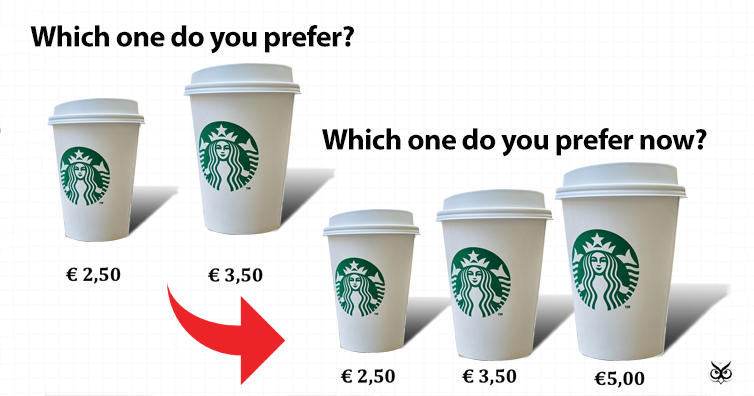Remember when we talked about the ‘Chivas Regal Effect’ and how brands are fooling you to pay more for less? Well, today we look at another highly successful, similar marketing technique called ‘Decoy effect’.
So, what is it?
Simply said, the ‘Decoy effect’ is the strategic placement of a third option that is asymmetrically dominated – meaning that the third option is, in all respects, inferior to one option but, compared to the other option, is inferior in some aspects and superior in others. Because most people have the tendency to avoid the most expensive option, by placing a third, middle option, what was previously considered expensive now becomes more reasonable. Here’s an example so you can better understand how this works. (the article continues after the ad)
Let’s say you are about to donate to a website. There are two options: 5$ donation and 10$ donation, each offering different rewards to the donator and obviously the rewards for the $10 donation are of greater value than the rewards of the $5 donation. Because the $10 donation is the most expensive option at the moment, most people will avoid it and go for the $5. In general, even though people want more awesome, they have the tendency to spend less money. So, how can a clever marketer alter your decision?
By adding a third option, a $15 donation with more rewards for the donator. This third option acts as a decoy – a simple mind game that makes the $10 donation look more reasonable and therefore increasing the overall value per customer. In addition, if the third-option is closer to the medium-option, let’s say $12 instead of $15, it will now make more sense for people to choose it, as with $2 more you are getting a much greater reward. Boom. Marketers have just transformed a $5 sale to a $12 sale. Ain’t that incredible?
An interesting study at Duke University put the ‘decoy effect’ to test and the results proved the theory. Subjects were initially given two options to eat: a really fancy, 5-star restaurant that was far away from their location and a medium, 3-star restaurant that was nearby. Quality or convenience? A simple dilemma but subjects hard a hard time deciding.
Now comes the decoy – a third option: a 4-star restaurant that was even further away than the 5-star restaurant. As expected, the tables turned. Now subjects were choosing the 5-star restaurant in great numbers!
Here’s also an experiment made by the National Geographic Channel:
The decoy effect is simple, yet extremely powerful and it affects our everyday decisions. It sounds too good to be true, but it really works. So make sure you are aware of it and always choose what you want and not just go for the middle option because it’s the “middle option”.
If you like what you read, then you will definitely love this one: The Chivas Regal Effect: How Brands Are Fooling You To Pay More For Less
Photo: Engin_Akyurt / Pixabay
Photoshop: I’m A Useless Info Junkie
Sources: How to Use the Decoy Effect to Help Buyers Choose the Right Option | Decoy effect

